Gull Trouble | What’s Going on With New England’s Seagulls?
At the same time more seagulls are showing up in coastal cities, their overall population is shrinking. What is going on with New England’s rascal bird?
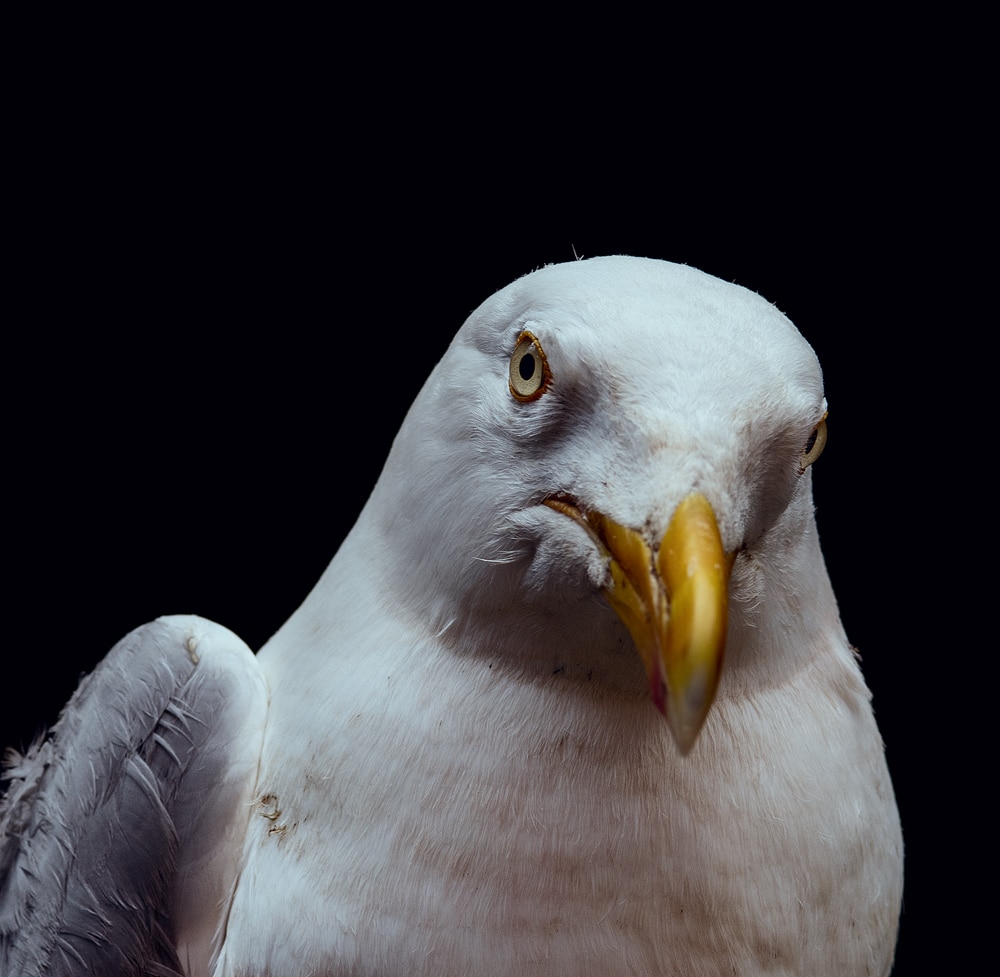
Coffee By Design | Portland, Maine
Photo Credit : Katherine Keenan
Photo Credit : Tristan Spinski
From the sidewalk five stories below, the adult herring gulls, with their distinctive bright white bodies and black-tipped gray wings, their chests puffed out, their heads held high, formed a striking phalanx atop the decorative half-moons of the PMA’s facade. Sometimes, the gulls spread their wings and swooped down, laughing their high-pitched haw haw haw as they scanned the ground for scraps of food. They perched atop lampposts. And, yes, they occasionally pooped on things. And people. In short, as gulls do, they acted like they owned the place.
Last June, University of New England ornithologist Noah Perlut opened the hatch to the museum’s largest roof and climbed up with two undergraduate assistants. Immediately, gulls lifted up in a low-swirling cloud of frantic flapping and screeching like a scene from Hitchcock’s The Birds. Perlut’s students cowered, eyes wide, each holding a crooked arm overhead for protection. But Perlut only smiled, unperturbed. He’d been studying Portland’s rooftop gulls for eight years. He knew the drill.
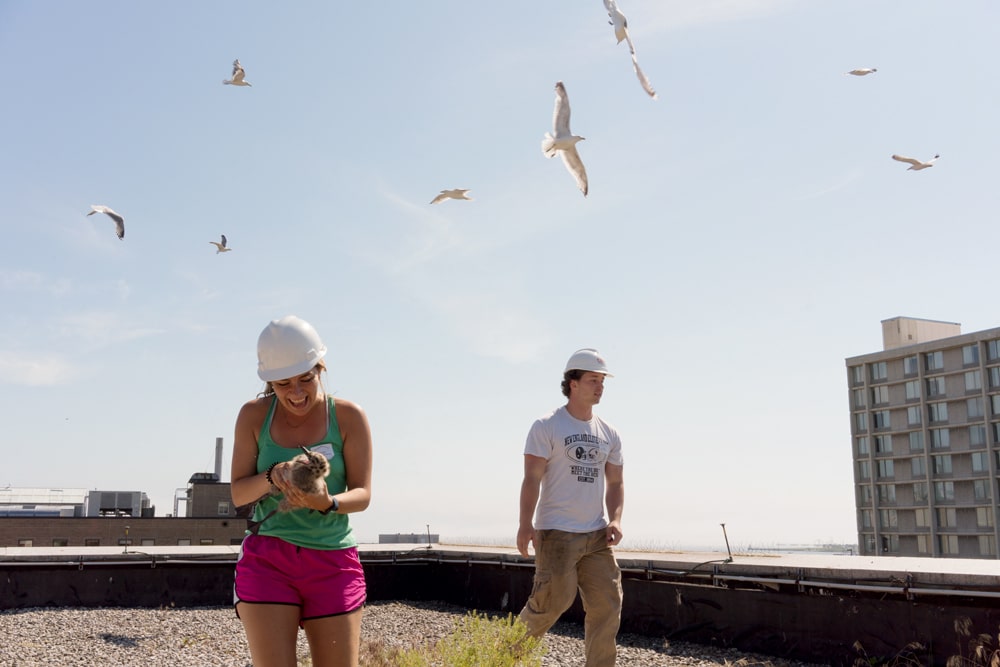
Photo Credit : Tristan Spinski
“You can go ahead and grab chicks!” Perlut yelled to his students before plopping down onto the gravel with a large cardboard box he’d brought to hold chicks waiting to be banded. Perlut, a tanned father of three with a surfer-dude chill about him, unzipped his frayed gray-and-green backpack and pulled out a notebook, pen, and Ziploc baggie of bands in UNE’s unique orange-and-black color combination, which helps amateur bird-watchers as far away as Texas identify these banded birds as his. Perlut’s gull study and many others rely on these amateur sightings to track birds via the federal website reportband.gov.
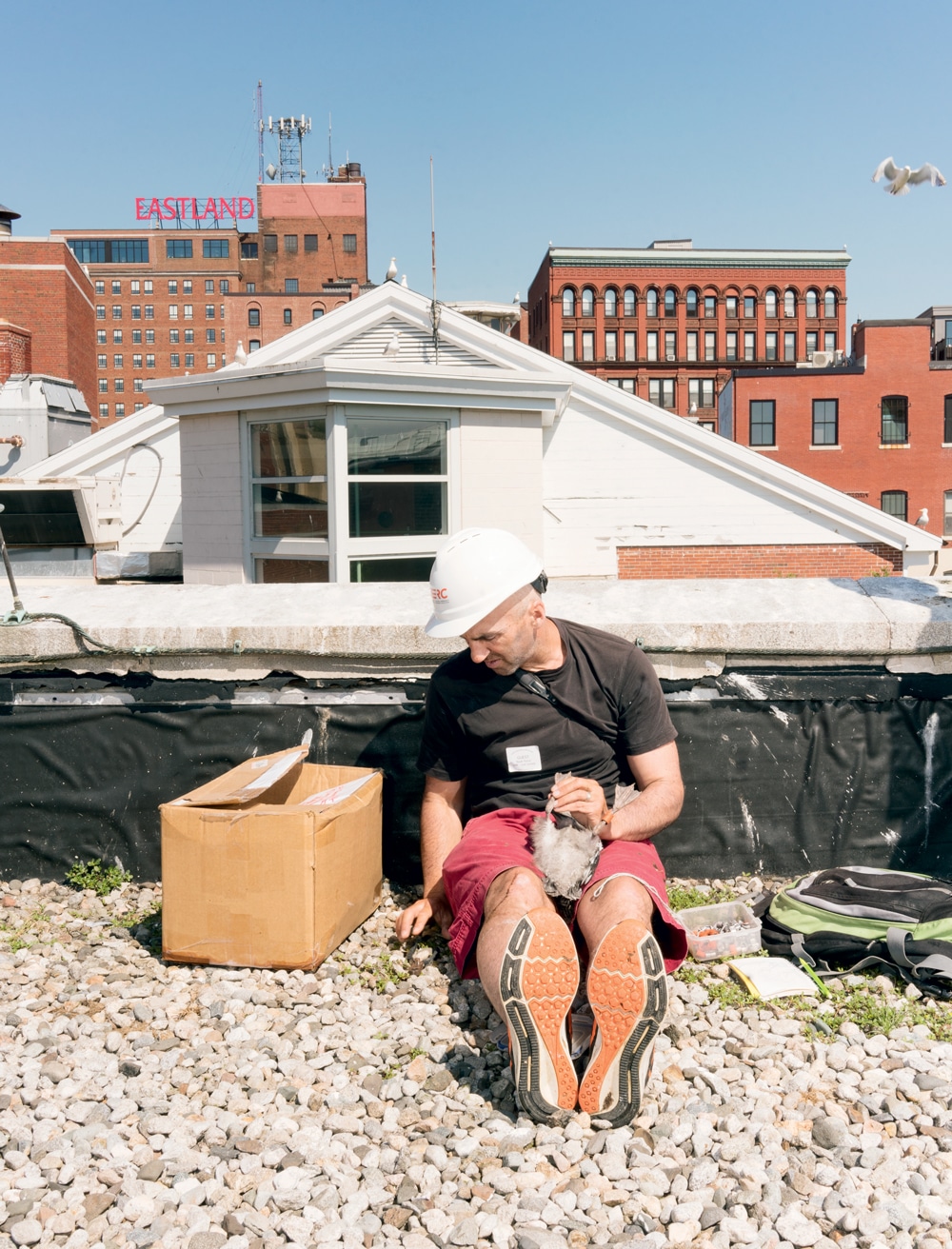
Photo Credit : Tristan Spinski
Gulls are migratory birds and usually nest on islands, but since at least the 1970s some herring gulls have chosen to rear their young on Portland rooftops. In 2011, the first year of his study, Perlut banded nine chicks on a single office building downtown. By the summer of 2019, he and his students were banding 148 chicks on 14 commercial rooftops in the center city, including the PMA. Perlut estimates there are around 300 chicks born on city rooftops every season in Portland, including in nests on houses, but he can’t say whether that’s a change from years past because counting birds isn’t what he’s after. He’s interested in why they’re here and how long they’ll stay. “Part of this is for the love of understanding the animals that we’re so in contact with every day,” he says. “They just have a bag full of mysterious behaviors that we see here on the street and we think it’s that simple, when their lives are in reality much more complicated.”
Portland may want to brace for an influx, if trends elsewhere are any indication. In coastal towns and cities in the United Kingdom, including London, the urban herring gull population has quadrupled since 2000 and has even spawned a genetically distinct subspecies. There are reports of gulls staggering drunk out of brewery vats, dive-bombing grannies and small children, and pecking a pet chihuahua to death. In Rome, Italy, yellow-legged gulls have lately terrorized tourists at the Forum, screeching and circling by the tens of thousands at sundown. Closer to home, the Jersey Shore town of Ocean City recently became the first on the East Coast to deploy trained falcons, hawks, and owls to scare away “increasingly aggressive” gulls that, according to town officials, had become “dependent on an unnatural supply of food stolen from people on the boardwalk and beach.”
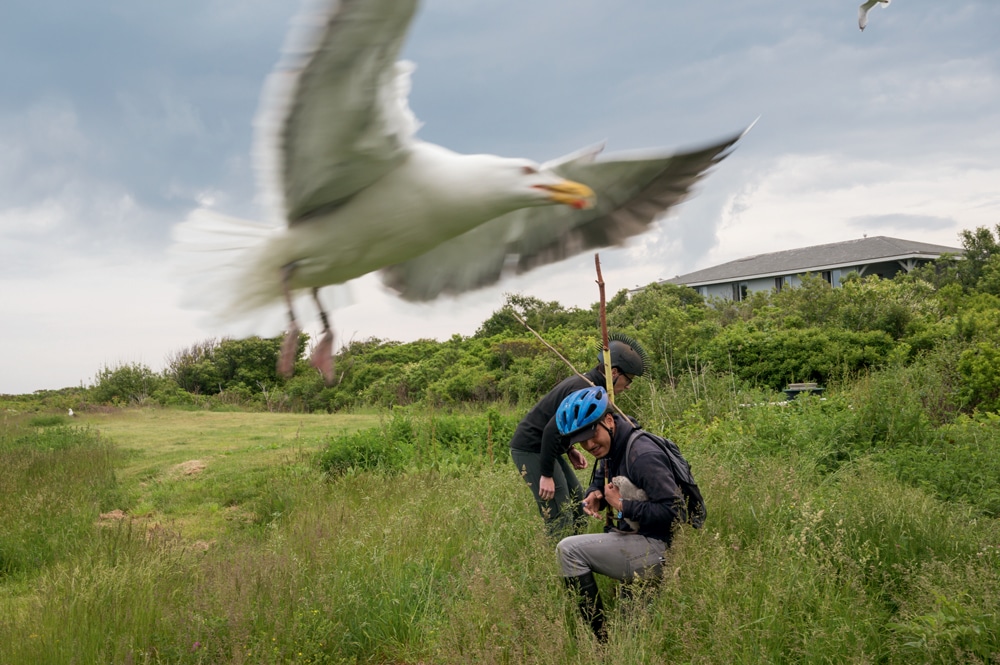
Photo Credit : Tristan Spinski
Here in New England, flocks of gulls in the street of Boston last winter mucked up the testing of self-driving cars, which identified the birds as a single, large roadblock for which they needed to wait indefinitely, while in York, Maine, a photograph of a tourist’s first-ever lobster roll being stolen by gull beak right out of her hand recently went viral.
And in Gloucester, Massachusetts, where the distance between the harbor and the downtown is only a couple of blocks, musician Bradley Royds recently made himself a lightning rod for the local love-’em-or-hate-’em gull debate by obtaining federal permits to remove nests from the roof of his downtown studio, where he’d noticed a loud and pernicious increase of the birds over the past five years. Gulls were ripping open trash bags, dive-bombing residents, and screeching from their city nests at all hours. What’s more, Royds says, gulls can carry disease. (They can carry E. coli bacteria, which can be transmitted to humans through the birds’ poop.) “This is an ecological and humanitarian effort to do the right thing for our town,” Royds says. “Otherwise they will move in and take over, and they have absolutely zero respect for humans. Or themselves, really. Vicious, vicious little creatures.”
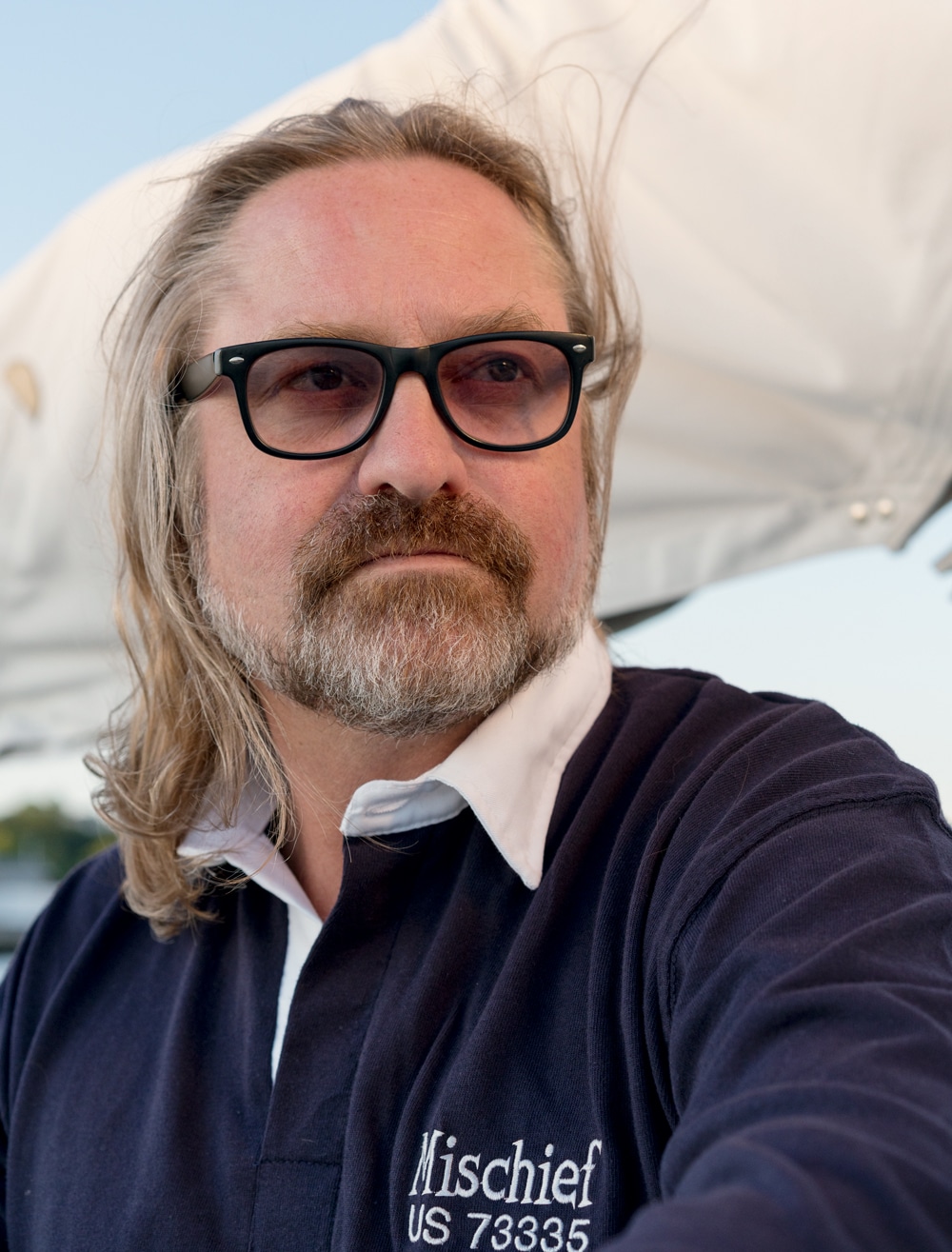
Photo Credit : Tristan Spinski
It’s this tension between the world of animals and the world of people that fascinates Perlut. Last summer, he was involved in more than half a dozen research projects, each on a different species, each from a different part of the globe, some long-term gigs, some one-offs, all linked by Perlut’s central concern of how wild animals adapt to life alongside humans. He got into gulls on a whim after watching the birds nest outside his wife’s office window in downtown Portland. He wondered: Will gulls that fail to procreate successfully in the city try again the next year? Are chicks born on these rooftops forever city birds that will mate and rear their own young here? “These are animals that are all around us, and sometimes we know it and sometimes we don’t,” he says. “The gulls in Portland are a great example of that, where they have this secret life that’s incredibly complex.”
That secret life is proving to be a problem lately, as scientists in New England scramble to explain the birds’ unprecedented decline. Both the herring gull and the great black-backed gull, the birds we New Englanders are most likely to call a “seagull”—a colloquial term that isn’t specific to any species—have declined in the Gulf of Maine at a rate of roughly 40 percent over the past decade. Over their two centuries of history in coastal New England, gulls have declined previously because of natural predation, environmental stressors, and a robust feather-poaching effort to supply the Victorian hat industry. They’ve always rebounded quickly, but not so lately. The population just keeps thinning.
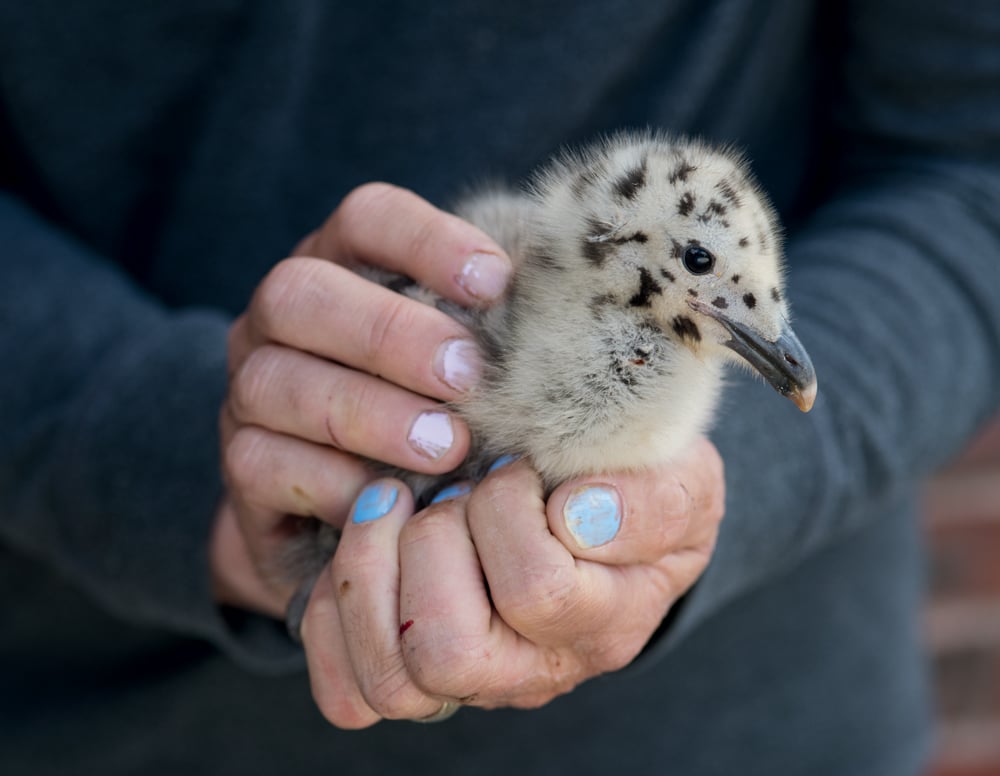
Photo Credit : Tristan Spinski
Perlut found out about the decline from a scientist buddy a couple of years into his study, and suddenly his quirky little impulse project became part of a big important picture. Could Portland and other communities on the Gulf of Maine be a refuge for gulls struggling to survive in the wild, as cities and towns elsewhere in the world appear to be?
That morning on the museum roof, one of Perlut’s students handed him a tawny weeks-old chick that had molted most of its fluff for young feathers. He turned the bird gently onto its back, rested it in his lap, and clamped a band loosely around its leg. “The dangers are equally present on an island versus a city—they’re just different dangers,” Perlut said, as the bird’s round black eyes blinked up at me. “On the rooftops, birds can fall off and die; birds can get heat stress and die; birds can be eaten by somebody else, including other gulls or predators, and die. On an island, gulls can be eaten by other gulls, particularly by other species of gulls, and there is also a much stronger potential for things like flooding, which could kill them, especially if they’re hatched closer to the shoreline. So there’s just different peril. And that’s really what our work has identified, that the perils are sort of equal in terms of the volume of them, but they affect the birds’ lives in different ways.”
Perlut stood the bird up on the gravel, and it rushed for the shelter of the border wall. Under the screeching chaos of the still-swarming adults, the juvenile jumped up onto the wall, panicked, and leaped off the building.
The students rushed to look over the edge. Below, a man and woman on the sidewalk outside a Starbucks crouched over the bird. “Hey!” the students shouted at the couple, waving their arms. “Yo!”
“Is he all right?” Perlut asked, fishing around in the cardboard box for another bird to band.
“It looks like he’s still alive,” one of the students said. “He’s hurt, though.”
About half an hour later, the gull was returned to the rooftop in a box. Its developing wings had saved its life, but it had a limp that Perlut said might be a sprained joint. The students opened the hatch and climbed down off the roof while Perlut lingered to check on the gull. He watched it stagger away. It stumbled and collapsed briefly in the brush near a nest, which made one of the adults still screeching overhead dive for it. The bird scrambled up and limped on. Perlut walked after it, checking to make sure it wasn’t fatally injured.
He returned, his normally jovial face tense. It’s not easy sometimes, watching what these birds go through. “As a scientist,” he said, “unless they’re really hurt, we have to let, sort of, natural courses.” He looked back at the young bird one last time while the swarming parents overhead continued to scream. It was getting late, and he had a lot more roofs to visit. He grabbed his backpack and disappeared down the ladder.
_
On the ocean, gulls are good luck. Gulls are strong, brave, commanding. They are harbingers of land, of fish just below the surface, of a coming storm. Legend has it they hold the souls of drowned sailors and fishermen, so killing one is bad luck. In Henry Wadsworth Longfellow’s epic 1855 poem, “The Song of Hiawatha,” when his hero is swallowed by a sturgeon, it’s the seagulls he calls to claw him out of the fish’s belly.
“Set me free from this dark prison, And henceforward and forever Men shall speak of your achievements, Calling you Kayoshk, the sea-gulls…the Noble Scratchers!”
Preeminent Dutch ornithologist Niko Tinbergen spent decades studying the European herring gull, a close cousin of the New England version, ultimately winning the Nobel Prize in 1973 in part for his gull research. From a blind that was little more than an overturned box tethered to the turf on the rocky shore, the bespectacled Tinbergen crouched over his notebook, peering at the birds to divine, as he wrote, “the secrets of community life.”
Turns out, gulls most of the time just like to chill. “One must persevere,” Tinbergen noted, “and never be discouraged when many hours go by without much of interest happening.” When they do, well, do something, it’s often kind of awkward. Tinbergen observed that the birds aren’t particularly great fliers, and their swimming and walking abilities are only so-so. To watch a gull dive for a fish, as he described it in his seminal 1953 account, The Herring Gull’s World, is like watching a ping-pong ball bobbing on the surface of the ocean: “The whole performance lacks the expertness that characterizes the analogous … diving of terns.” If they wow at anything, Tinbergen decided, it’s being a little bit good at all things. Gulls are consummate generalists. They reminded him of another consummate generalist: human beings. “The student of behavior is struck by the deeper similarity between man and animals,” he wrote. “It is as if the animals are continuously holding a mirror in front of the observer, and it must be said that the reflection, if properly understood, is often rather embarrassing.”
On Great Duck Island, off the coast of Maine’s Acadia National Park, College of the Atlantic professor John Anderson has spent more than 20 years observing the birds. Like Tinbergen, he finds he can relate to them—their individualism, their tenacity, their penchant for literally shooting the breeze. He likes to climb to the top of the Great Duck Island Lighthouse and watch the birds circling idly in flight. “I think that gulls show every apparent indication of what we call joy,” he says. “They’re having fun. I mean, if you could jump off a high place and soar, wouldn’t you?”
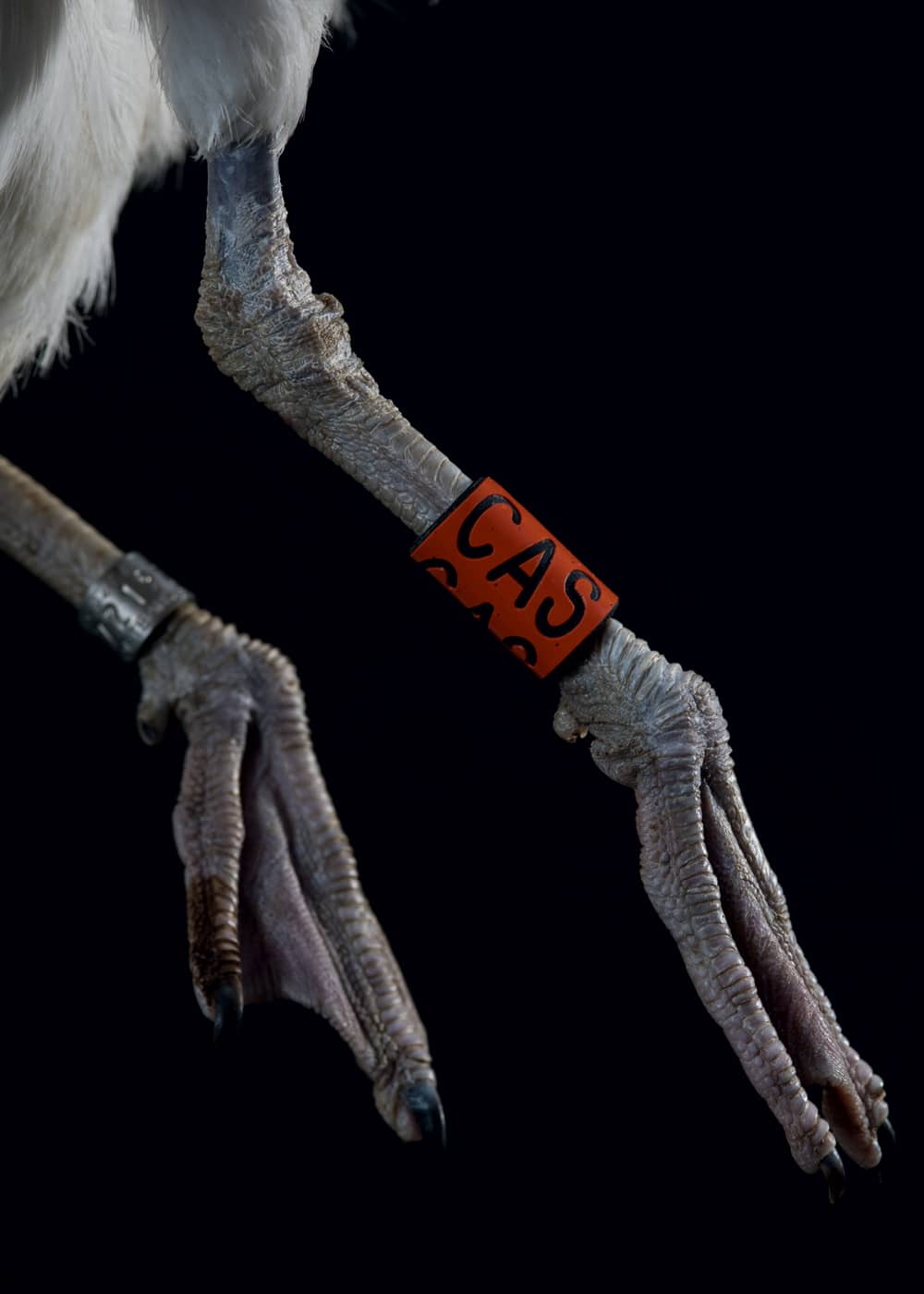
Photo Credit : Tristan Spinski
A few years back, Anderson noticed a persistent and widespread decline in New England’s gull populations that he couldn’t pin to any specific stressor. It’s a trend that’s in keeping with broader threats to birds in North America. Last year, the journal Science published a study that found that the total bird population in the United States and Canada has gone down by 29 percent—roughly 3 billion birds—since the 1970s. And while critics assert that a decline in gulls in particular is merely a correction for a population artificially ballooned by landfills that were open from the 1970s to 1990s, Anderson says that while the decline actually began around the same time that open landfills in Maine were being capped, it really accelerated after they had been closed for some years.
“I don’t think it’s a simple cause and effect,” he says. Instead, the continuing species-wide decline of these generalist birds is “to me very scary, because it suggests that multiple things are happening in the environment. We’re looking at a perfect storm of increased predation, declining food sources, changes in fishery patterns, and none of it is good for gulls.”
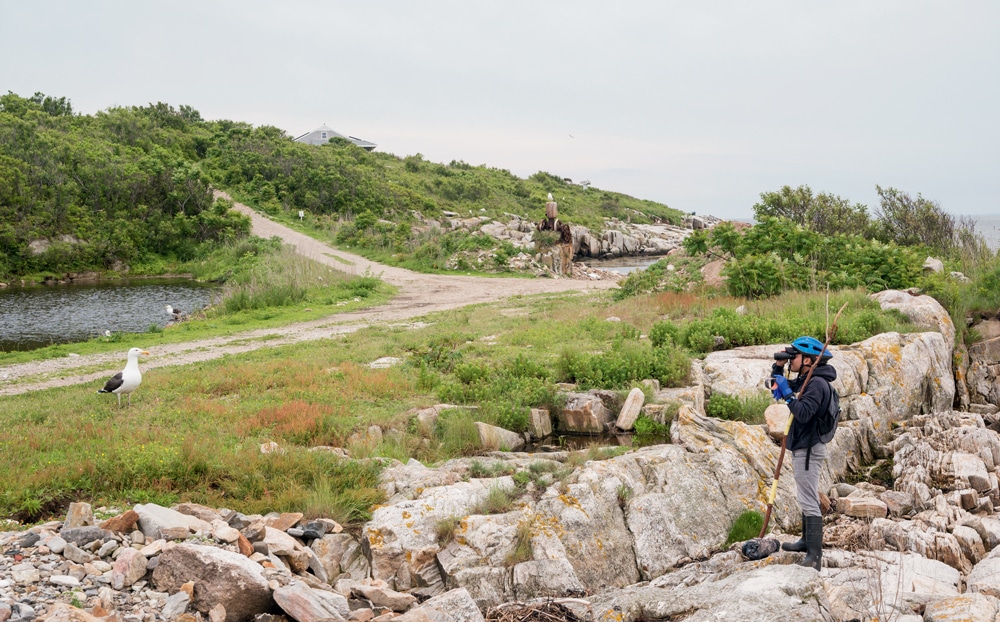
Photo Credit : Tristan Spinski
None of it is good for people, either, Anderson argues. If these highly adaptable birds—there are 36 species in the gull family Laridae, inhabiting every part of the globe, including Antarctica, nesting in all kinds of landscapes, and eating all kinds of food—if these birds can’t make the Gulf of Maine work for them, what does that mean for us humans?
In 2013, alarmed by the persistent decline in gull numbers and its implications for the Gulf of Maine at large, Anderson created the Gull Working Group, a loose affiliation of gull biologists who share findings to try to solve the mystery of the birds’ decline. (Noah Perlut is a member.) The researchers have found that many of the most common species of gulls in the North Atlantic are in decline, including gulls in Finland, the British Isles, and Eastern Canada. Climate is a probable common factor, although current evidence doesn’t point to its being the primary cause.
“Particularly here in the United States, a lot of the emphasis in the 20th century was on gulls as pests, and the potential impact of gulls on other species, and gull management,” says Anderson. “I think now we’re moving into a very different place, where there are more and more of us who are sort of rethinking gulls. And we’re now confronting this business of major declines and having to work out what that might mean in the broader sense.”
_
New England’s herring gulls might be amenable to city life, but the region’s second most common gull, the great black-backed, might not be. Great black-backeds are the largest gulls in the world, with a six-foot wingspan, an ornery temperament, and a reliance on marine-based food sources. That worries Sarah Courchesne, an associate professor of natural sciences at Northern Essex Community College in Haverhill, Massachusetts, and codirector of the gull research program on Appledore Island, off the New Hampshire coast. Courchesne has seen the number of great black-backed breeding pairs on Appledore decline by roughly 60 percent since the early 2000s. Because black-backeds aren’t as flexible as herring gulls in their feeding habits, a drop like this could mean they “just kind of disappear from our landscape,” Courchesne says.
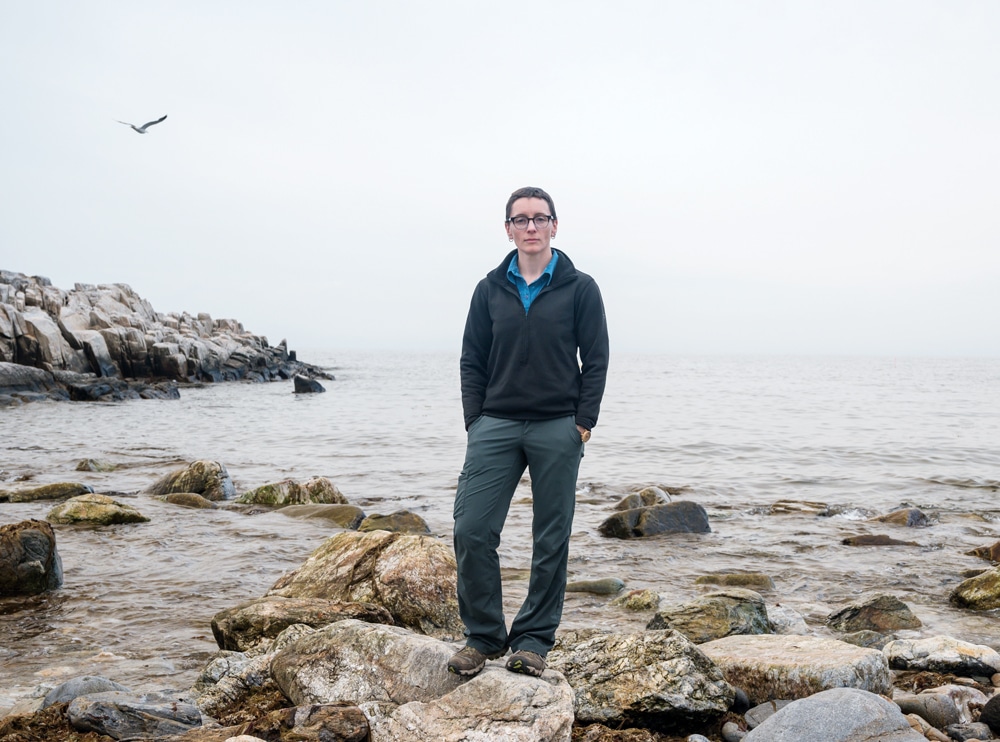
Photo Credit : Tristan Spinski
I met Courchesne at the height of summer breeding season on Appledore Island. She was there to check in with her summer interns, one of whom was researching whether great black-backed gulls are developing an adaptation to better accommodate life among humans. As we walked the island’s trails that morning, we passed a volatile tapestry of nests, each of which was manned by at least one very protective parent, and dozens of herring gulls and great black-backed gulls keeping watch from the roofs of the island’s dormitories and research buildings. Being dive-bombed by one of these birds triggers a primitive, hit-the-dirt panic. To this end, it’s wise to wear a helmet around Appledore’s gulls. Outside the mess hall, a good Samaritan had laid a pile of sticks for anyone who’d forgotten their helmet that day. (Gulls protecting offspring tend to dive for the highest point, and it’s better a stick held aloft be that point than your head.) A few summers before, an intern had braved the island without helmet or stick only to be concussed by a diving great black-backed gull and emergency-ferried back to the mainland.
Courchesne is forgiving, though. “Some of them are really quite gentle,” she says. “Some of them you can almost pick up by hand when they’re sitting on their nest. And others are incredibly defensive of their offspring. That just strikes me as very human.”

Photo Credit : Tristan Spinski
The summer I visited, it was sophomore Brielle Michener’s job to provoke great black-backed parents. Continuing a gull-triggering experiment that had started the previous year, Michener, a farm girl from Massachusetts, would put on a bright blue poncho to become the same generic blob of color as last summer’s intern, squish a round black bike helmet over her blonde curls, and stand very close to a nest with eggs or hatched chicks to see how the parent reacts. Short answer: They didn’t like it. In fact, the birds got so angry Michener had to modify the way she logged their response. At the bottom of the typed scale she had tucked into her notebook that day, with “0” being no reaction at all and “7” being charging at her, she showed me where she’d scrawled an “8” in black pen, for times when the gulls flew at her head or bit her ankles.
Thankfully, contact like that was rare. More often, when Michener approached a nest in the brush, the bobbing head of a black-backed parent would lift up sharply, and the bird would let out a repetitive, guttural ah-ah or ow-ow that continued loudly until she backed away. Though it was probably meant to sound scary, it sounded scared, Michener thought, and she once asked Courchesne what to make of it. Courchesne had told her that over the years, she’d seen these big, intimidating gulls get as panicked by approaching humans as they did flyovers from predators like bald eagles. “People might think they’re being a nuisance acting like this,” Michener explained to me, “but they’re really terrified.”
Michener’s research was directed by Kristen Covino, an assistant professor of biology at Loyola Marymount University in Los Angeles, as part of a broad study of hormones in great black-backeds. Michener had discovered that many of the island’s most aggressive gulls had paired up with other highly aggressive gulls rather than choosing a mellower partner who might blunt their sharp edges. The result, Courchesne says, will likely be extra-aggressive offspring.
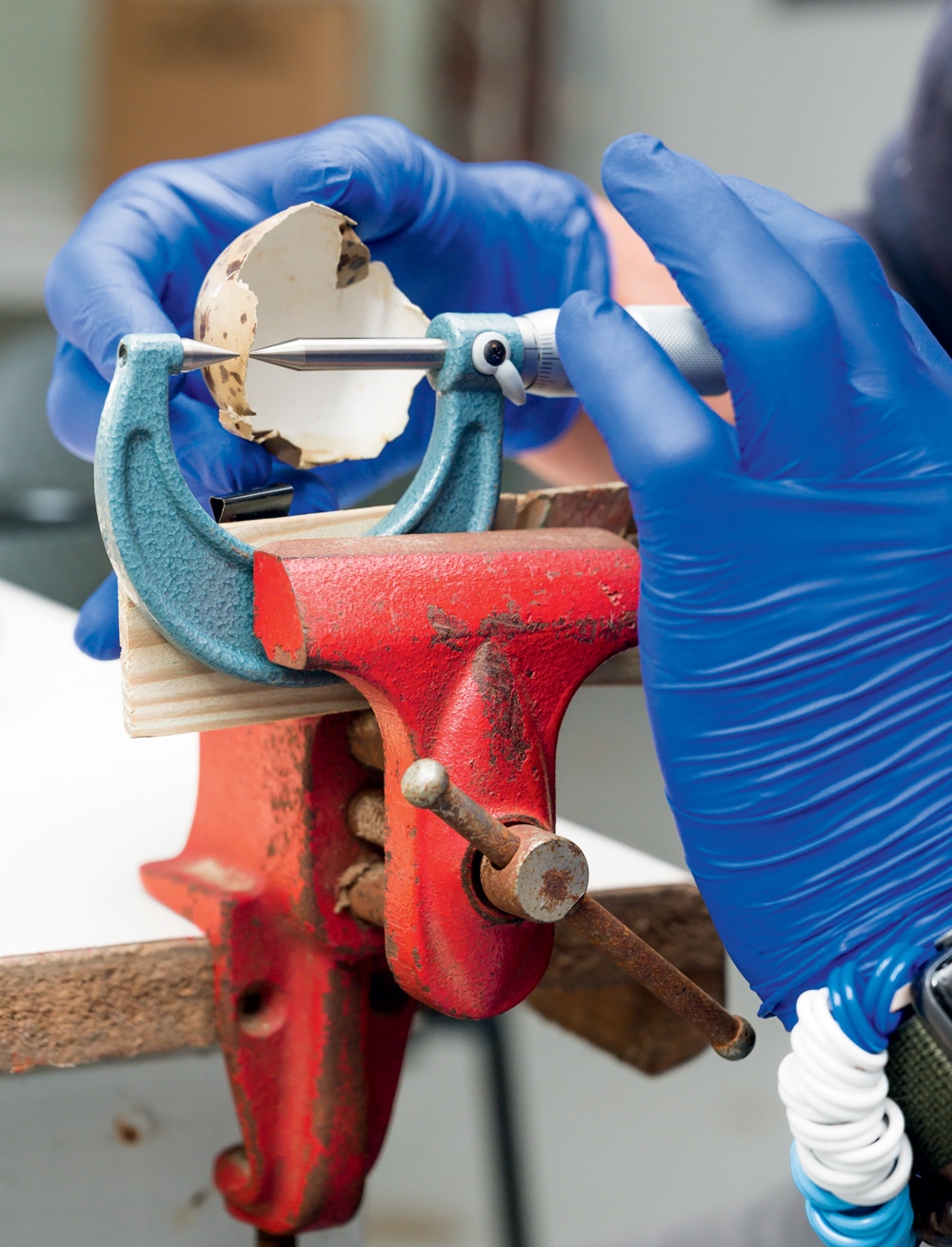
Photo Credit : Tristan Spinski
“Is there a benefit to pairing off with another aggressive bird and making offspring that tend to be more aggressive?” she says. “It might actually be maladaptive to be too reactive to humans. We just don’t know.” Courchesne says so little is known about these birds, she’s not even sure aggressive pairings are unusual. “But my hope for them,” she says, “if I’m trying to find an angle where I don’t get completely pessimistic about their prospects for continuing to exist, is that they are individually, behaviorally plastic enough that a specific bird could deal with these challenges and change its behavior and find a way to make its way through the world. That’s my hope with these gulls.”
_
A few days before joining Noah Perlut on the roof of the Portland Museum of Art, I met him next door at the Children’s Museum & Theatre of Maine. The museum had contacted him about a herring gull nesting behind the wooden-pirate-ship play area. Unlike the PMA, the children’s museum had only this one nest, and that was a fluke. “Occasionally the babies will fall down [from the PMA] once they’re learning to fly and they’ll end up in the backyard,” says Tara Fletcher, the museum’s exhibits and visitor services assistant. “And we’ll just kind of shoo them out and they meet up with their parents in the parking lot.” The children’s museum had asked the PMA for the name of its bird guy, and one morning before the museum opened, Perlut showed up to band the gull.
It had rained the night before, and the only sound was the shoosh of traffic on Free Street, on the other side of the building. “I’m going to try and catch this bird by hand,” Perlut said, eyeing the gull, which sat in blissful ignorance in its nest, flanked by trash bins. “And then I’ll take this pant leg”—he waved a worn piece of khaki—“and stick it over its head to cover its eyes. That calms it down.”
Perlut clucked gently at the bird, which squirmed and began to squawk the closer he got. When the bird stood up he rushed at it, pinning its wings, and his assistant put the pant leg over the bird’s head, which calmed it enough to allow Perlut to strap a lightweight satellite tracking device to its back. Perlut has only a handful of the devices, which are about the size of a flip phone, and they fall off in a year, he said, but in the meantime this tracker will provide him with the bird’s location every four hours. From this one gull, Perlut can learn a lot: where it goes to forage, where it migrates during the winter, whether it returns to the city next summer.
A couple of months later, as summer began to fade, I got an email from Perlut titled “Children’s Museum gull.”
“Just a quick update,” Perlut wrote. “Looks like she is still hanging out in the Greater Portland area.” The attached map showed the gull’s summer travel in red lines that splayed out from the museum in a star shape, each line representing one flight. The star looked as if it had been drawn with an extra-thick marker because the movements were so repetitive—layers upon layers of red lines. The gull had traveled to Long Island in Casco Bay, Westbrook, and Scarborough, but stayed mostly on the Portland peninsula. These were the wanderings of a city mother, foraging for her children from her downtown home.
Staring at the star, I was drawn to a point stretching south, darker and longer than all of the others. A favorite track, it extended straight down off the map over the swath of blue that represented the Atlantic Ocean. I imagined the gull flying over an expanse of glistening ocean, an ocean that seemed to go on forever, flying far and fast and strong. I hoped some of that flight was for the sheer exuberance of defying gravity. I hoped, as John Anderson had told me, it was for the joy of it.








Interesting article. though I live in Arizona I spend summers in Seattle on the Puget Sound. There are resident bald eagles but they are no match for a flock of sea gulls protecting their nests. Sad to see our national bird being run off by sea gulls.Kind of like the US looks compared to the rest of the world during this global pandemic. As the article states these birds can be really aggressive! Thanks.
Well, there is no apparent decline here in New Bedford, MA. We have had one nest on the building for many years, then a couple of years ago we had two. Now we have at least four nests with what appears to be 3 chicks in each. And yes, they are quite aggressive! We can no longer work on the roof leaks once the chicks hatch, and employees are often dive bombed going to their cars in the parking lot. They are becoming a problem.
I can promise you, there is no shortage of gulls here in Gloucester. A couple of years ago I was walking from my unit to my car, with a ham and cheese sandwich in my hand. A gull swooped down from a telephone pole, managed to snatch the ham from my sandwich, leaving me with a cheese sandwich. My neighbor tells me they like hotdogs even more????
Felice July 8, 2020
I was told that first time gull parents are quite aggressive & protective of their eggs & then babies. When having a second batch they tend to clam down & not react as aggressively to people. My experience has been from being on Appledore Island, which is located in Maine. Goss Harbor divides Star Island located in NH (Rye) from Appledore Island located in Kittery ME. Appledore Island owned by UNH & Cornell University is the only undergraduate college level program in the US. I don’t know for sure if what I mentioned about gull parents reaction is accurate but seems very human like related to having a first born, then a second baby!
After 15 years in Massachusetts, 20 years in Brooklyn, am familiar with gulls. Was surprised to see in 1993 many seagulls in Chattanooga TN.
They apparently were driven here by a hurricane in the gulf.
For the last few years their numbers have declined greatly. They were mostly in the Malls eating what they could get.
They were also at the TN river, high on the surrounding power lines.
Not so much anymore, just thought you may find this interesting.
The article states that seagulls are vicious and have no respect for humans. I believe we are misinterpreting their opportunistic nature for viciousness. Stealing/obtaining food from humans is a learned behavior, not an innate one. Just like their primate counterparts in other countries. It’s a tough cycle impossible to,break.
Last year , when i was on the coast of New Hampshire ( North Hampton) I took a photo of a seagull on the beach. Upon enlarging the photo on my computer, I noticed a numbered band on the bird’s leg. I found the Appledore project and reported the band number to them . They in turn emailed me back with the history of that particular seagull. It made me want to find more birds to photograph and obtain numbers , but I was not able to find any more with bands on their legs. What is also affecting the birds , is plastic waste that is small enough to be consumed. The birds mistake it for food. While it is fun for the tourists to hold up french fries for the birds to eat, french fries are not good for the birds and that should be discouraged , but as with anything else , when you try to tell someone that something is not good and you shouldn’t do it, they look at you and you can see that they are thinking ” who died and left you boss?” Ignorance abounds in this country. I was very grateful for Sarah Courchesne giving me the history of that particular Seagull and if I am able to , I will continue to be a Citizen Scientist and assist when I can.
#FlyingRats but critical to the ecology.
In Maine I once heard from someone whose house overlooked a herring gull nesting area as well as a bald eagle nest that the eagles would eat the gull chicks, so it is not surprising to hear that the flock of gulls would try to protect their nests. I hear that eagle populations are rebounding